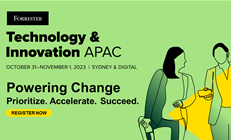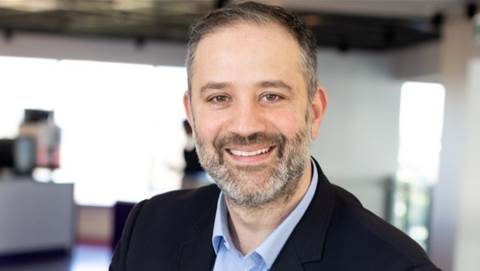Each year the number of great Australian technology projects uncovered through the iTnews Benchmark Awards has grown, and this year we reached an all-time high.

The continuing strength of the program is a direct reflection of the clout of the Australian IT market - something we fiercely believe should be showcased and supported.
We’re proud to run an awards program that celebrates innovation, ambition, and risk-taking alongside return on investment, especially when it’s often the IT bungles, breaches, and blackouts that make the headlines.
And like the innovative projects that we celebrate, here at iTnews we recognise that we too have to move with the times.
That's why we've made a few tweaks to the program this year.
We understand that success is a group effort and not limited to a single individual, so you'll notice that we're now recognising the entire team as well as the CIO or IT leader who spearheaded the project.
We've also added a new category to the awards program to shine a light on the more junior members of Australia's IT shops. The Rising Star award is our way of celebrating the next generation of IT leaders.
And lastly, we've finetuned two of the categories - Industrial and Telco/Media - to better represent those markets.
Please join us in congratulating the following finalists:
FEDERAL GOVERNMENT
|
Australia Post |
Australia Post has been busily working to reinvent itself in recent years in the face of a rapidly declining letters business. This existential crisis has forced it to take a long, hard look at its core proposition and how best to serve its customers. With one of the largest retail networks in the country and a status as a trusted organisation, Australia Post is repositioning itself as a provider of many services to the community - with a clear focus on online. Its early strategic manoeuvres with its Digital ID identity verification solution have seen organisations across verticals flock to the fledgling service, and will likely cement Australia Post as the first identity provider on the DTA's whole-of-government Govpass digital identity framework. This, plus the opportunity to convert the six-and-a-half million identity verifications it performs in its retail centres each year, puts the Digital ID platform on the path to success. |
|
Department of Veterans' Affairs |
A major digital transformation of the way the Department of Veterans Affairs processes applications for military benefits has taken months and many headaches out of the process. In an effort that spanned several government agencies, DVA led the development of a bespoke platform that replaces a 16-page paper form with just three to five questions, delivered online. It has slashed the average processing time from 107 days to 30 days. And back-end links to legal information provider GovLawTech ensures any changes to legislation are automatically reflected in the system. The project has made eligibility a lot clearer for veterans and removed confusion that had characterised the previous process, while dramatically increasing the chances that the application is processed correctly the first time. |
|
National Library |
Surging volumes of digital content were creating major logistical issues for the National Library of Australia, and it quickly became clear that its existing systems weren’t going to keep up with long-term demand. The digital library infrastructure replacement (DLIR) project saw the introduction of numerous digital archiving, OCR, image conversion and collection management tools, backed by an open source framework that has sped digitisation processes by up to 80 percent. Additionally, a new digital deposit service has boosted efficiency by allowing external parties to submit digital materials directly to the NLA – validating the library’s largest-ever software development and putting it in good stead to meet demand for the next decade. |
FINANCE
|
Minter Ellison |
Law firm Minter Ellison wanted to move from state-based silos of e-discovery to a national capability underpinned by a single cloud-based platform. It also wanted to find a way to better transfer encrypted data to and from third parties involved in the e-discovery process, like data forensics specialists. The result is improved service and reduced costs for its clients - and the first success in a broader push to migrate business apps into the public cloud. |
|
A big investment into ING's IT architecture in recent years has set the online bank up perfectly to move quickly on financial services innovation. Its rebuild to an architecture based on Google's Polymer application toolkit and the API Blueprint platform has allowed it to deploy features like its new 'every round up' digital money saver tool. While the idea isn't original - smaller players like Acorns and Moneybox offer similar products - ING's technology smarts have allowed it to react fast in a market where smaller, more nimble players are threatening to snap up the established players' market share. |
|
|
Suncorp |
Waiting for an outcome on your insurance claim, generally just after you've been through a stressful situation, is not an experience anybody enjoys. Suncorp already offered an online self service portal to make the lodgement of claims easier, but customers were still reliant on a human operator to review their claim. The insurer wanted to reduce the amount of time it took for most of its users to lodge and have their claims assessed. An initial test of IBM's Watson natural language classifier quickly turned into a full deployment that has since extended to the group's GIO, APIA, and Bingle brands. After feeding Watson 15,000 de-personalised claims and their resulting liability determinations, Suncorp's creative application of the technology means it is now able to automatically correctly assess a claim in 90 percent of cases. For motor insurance customers, it has meant five minutes after their claim has been lodged online they can be out booking repairs for their vehicle. |
EDUCATION
|
Deakin University |
A homegrown virtual assistant for students looks likely to be the catalyst for the formation of an AI and IoT start-up spun out of Deakin University next year. Deakin's Genie assistant is a suite of chatbots, artificial intelligence, voice recognition, and a predictive analytics engine that is intended to help students keep track of their campus lives. It does everything from nudge students if they haven't been studying enough to helping them keep on top of upcoming assignments and exams. The platform was built by Deakin’s internal IT team, and just months after officially going live, the university is already fielding requests from other organisations for the technology - so much so that Deakin CIO William Confalonieri has been given permission to start the engines on commercialisation. |
|
Griffith University |
Recognising that limited access to climate change datasets can compromise advancements in the field, Griffith University embarked on a major big data project to significantly improve climate change education and research around the world. Its biodiversity and climate change virtual laboratory (BCCVL) was built from the ground up using open source tools as well as the computing resources of the nationwide NeCTAR research cloud. The platform, which lets users develop and run complex modelling experiments across hundreds of layers of spatial data, in its short time has already become a significant global resource. More than 2200 students and researchers at 300 institutions in 18 countries are leveraging the BCCVL to conduct real-time modelling and experiments that support their own work on climate change. |
|
University of Newcastle |
A virtual reality application developed by the University of Newcastle is giving midwifery students hands-on experience resuscitating a newborn baby, without the real-world risks. Students previously had access to just a single lab session each semester to learn the procedure and test their skills. The new VR application gives them the opportunity to test and learn as many times as they like in a realistic setting, with or without the assistance of a virtual helper. Early results show midwifery students are using the app six times each on average, and choosing to do so most of the time off their own bat. |
STATE AND LOCAL GOVERNMENT
|
Department of Health and Human Services Victoria |
For over a decade, Victoria Police had been faxing an average of 71,000 paper forms to the Department of Health and Human Services for referral to family violence and protection agencies. All parties involved knew the process was inefficient and hampered response co-ordination across agencies, but the number of agencies involved along with the sensitive nature of the data and the constraints of traditional IT delivery models made the challenge seem too great. The problem was only exacerbated as volumes of referrals grew, but a 2016 royal commission into family violence proved the impetus to get the project started. With $1.7 million in funding, the DHHS IT team put its collective heads down, and six months later, its new Siebel L17 family violence web application was in operation. Doing development in-house and leveraging existing platforms avoided procurement headaches, while establishing a close, agile working relationship with police ensured user requirements were properly met. Now, family violence cases for the first time can be referred, tracked, reviewed and responded to by multiple agencies using a single online interface. |
|
NSW Department of Planning and Environment |
The sharing and enabling environmental data (SEED) platform is a public-facing portal that brings together over 1200 scientific datasets on land, air and water from nine state agencies and bodies in a single place. The site is deceptively simple to navigate; taking out the complexity required seven IT systems integrated for the first time. The result is an example of what can be achieved by government when they commit to open data. |
|
City of Melbourne |
Over the next 15 years, the City of Melbourne will take on another 70,000 residents, placing increasing pressure on how public services are delivered. This challenge led the IT team to look for a way to deliver services without the high-cost, manual and often inconvenient processes of the past. It has resulted in a complete overhaul of the predominantly paper-based way Melburnians previously interacted with the city, with a SaaS-based digital services platform that puts the needs of users first. The platform has allowed the council to unshackle itself from a few large IT vendors and vastly speed up its development cycle, shipping products months faster than it previously could. The digital services platform has been built in a way that allows the city to respond to changing user needs quickly and scale up as required. It will serve as the foundation for future digital transformation efforts at the council. |
INDUSTRIAL
|
Sydney Water |
Like many organisations, Sydney Water is doubling down on efforts to understand its customers, but with a difference. It has created a ‘customer hub’ that uses data drawn from across the company to predict issues before they turn into customer-facing problems and to send proactive notifications about them. It’s early days so the full scale of the ambition is yet to be realised, but the hub is active for over one million customers in Sydney’s west - and this is very much a project to watch. |
|
Momentum Energy |
Momentum Energy's billing system had grown over many years to become its primary customer relationship management tool, but with competition increasing and customer expectations surging, the platform could no longer keep up. A massive overhaul of the core environment saw Momentum shift to the cloud-based Salesforce CRM platform, with a large data consolidation project providing the long-elusive single view of the customer. The new Alchemy system has delivered portal-based self service and a host of backend integrations that streamline processes like credit checks, bad debt management, product ordering, and mobile access. Extensive involvement from staff and executives ensured the platform met both internal and external needs. Within a month of go-live, Momentum had set a monthly sales record – signalling a reinvention of customer service that will help it meet the ever-changing expectations of digital-savvy customers. |
|
Newcrest Mining |
Mines are often in remote, relatively inaccessible locations, but Newcrest’s Lihir Island takes that to another level. It’s 200 km from the nearest provincial city and 800 km from Port Moresby - and that became a growing problem as connectivity to the site stalled its digital mining ambitions. When conventional connectivity options were exhausted, Newcrest found a way to boost bandwidth to the site by 600 percent by bringing two telcos together for the first time. |
TELCO/MEDIA
|
Nine |
Marketing advertising time on commercial TV networks had long followed heavily manual processes, with rates set based on audience projections that were often best-guesses using marginally-related figures. Nine set about reinventing the audience projection process by integrating a number of big data analytics tools into a platform called 9Predict – which applies data science to massive datasets to deliver audience projections that quickly proved to be 20 percent more accurate than previous manual methods. Better numbers mean Nine is less likely to have to refund advertisers if real viewership doesn’t meet predictions – potentially saving millions of dollars per year. It has also improved modelling of projected audiences for video-on-demand (VOD) content, enabling Nine to better commercialise that fast-growing arm of its business and give the network a competitive advantage in a cut-throat industry that is still adapting to the challenges of the online era. |
|
Aussie Broadband |
Rapid growth is the goal of every small company, but for customer-facing businesses like national broadband network (NBN) retail service provider Aussie Broadband, it can also pose new challenges. Recognising that automation would help it grow without having to add more customer support staff, the firm built a bespoke system that integrated its customer environment with NBN Co’s service provisioning system. The new system automatically commissions services for customers from other RSPs within minutes. Order processing time has dropped from 13 minutes to 2.6 minutes – saving over $100,000 per year. The system will also support Aussie Broadband’s Wideband Networks corporate arm, delivering even more benefits as its customer base grows into the future. |
|
REA Group |
REA and NAB had nine months to deliver a “world-first experience” to people in the market for property. The idea was to create a single portal through which potential homeowners could search for property, receive conditional online approval for a home loan, and then see how that loan could help them buy the property of their dreams. The two companies had very different ways of working and a mid-project crisis, but kept their composure to deliver on-time and budget. The result is a world-first where customers browsing property can properly understand their ability to purchase it. |
HEALTHCARE
|
ACT Health |
A radical transformation at ACT Health has banished the paper records at the point of care that are responsible for wrongly-labelled blood samples and medication in hospitals. Now, when a blood sample is taken, a clinician is required to scan the GS1-standard barcodes on both their own ID card and the patient's wristband before a label can be scanned and printed onto a blood tube by a computer-on-wheels at the bedside. It means a label can only be printed in the patient's presence, reducing the risk that the label will be incorrect or misapplied. The effort required modifications to eight separate IT systems provided by different vendors. Not only has the health directorate already recorded a 40 percent reduction in wrong blood in tube incidents, but it has also wiped eight hours of nursing time off per day per ward. |
|
Catholic Healthcare |
A single application on a mobile tablet has significantly reduced the volume of calls to Catholic Healthcare's call centre and given its elderly clients more control over their lives. Samsung tablets with the aged care Breezie interface network with the not-for-profit's line-of-business system to give its home care customers the ability to access and control their schedule of care visits. Queries about which carer was coming and when formed a large part of the load on Catholic Healthcare's call centre - the app is now freeing these workers up to deal with more complex enquiries. It also gives users the ability to enter a video call with their care advisor without having to remember any authentication credentials, thanks to the inclusion of the OAuth protocol. Catholic Health is now looking at augmenting the platform to potentially support health monitoring through IoT devices, and whether the portal can facilitate financial transactions. |
|
Thomas Holt |
Thomas Holt's aged care residents were becoming increasingly more technologically-savvy than the provider that was responsible for their living services. The not-for-profit saw the writing on the wall and took the opportunity of the greenfields build of its new Seymour Shaw residential care home to change things. Now, residents at the facility are surrounded by robots, sensors, circadian rhythmic lighting, and wearable devices, all interacting with Thomas Holt's centrepiece LiveCare360 platform to provide a single, holistic view of the individual. Importantly, the system is reaping benefits not only in terms of healthcare and illness prevention, but also giving its baby boomer customers the same lifestyle they'd had outside of the care facility. |
CONSUMER
|
Carsales |
Carsales is one of the few organisations to reap long-lasting success from the hackathon model. An idea one year ago to use machine learning and artificial intelligence to take significant pain out of sorting images of cars is already proving its worth. Not only has it cut out 55 hours of handling time per day for the 20,000 daily images Carsales workers were manually categorising, the firm's private and dealer customers are using the technology to do the same in their own operations. |
|
Rugby Australia |
Trainers and coaches at Rugby Australia had invested heavily in systems to collect biometric and performance data on their athletes, but a lack of integration between these systems meant data analysis relied on piecemeal manual processes. Development of the high performance unit analytics platform integrated a number of data management and visualisation tools to consolidate player data and make it available to stakeholders through a variety of methods. This integration and the elimination of manual reporting has paved the way for rapid analytics that lets teams adjust players and match strategies on the fly. |
|
EB Games |
Building an online presence around a legacy of physical retail locations has challenged every retailer, but EB Games Australia has set the global pace for parent company GameStop after overhauling its online presence to run completely in the cloud. Rather than a lift-and-shift infrastructure-as-a-service (IaaS) migration, the development team went back to the foundations, integrating a range of commercial and open source tools to develop a lean, flexible and scalable framework that runs on AWS platform-as-a-service (PaaS) infrastructure. The new platform not only streamlines the online sale of products, but has integrated online and retail operations by enabling omni-channel marketing and customer loyalty outreach. Scalability and availability have proven good enough to support demand surges around high volume, limited edition releases – which has driven a sales uplift that pushed return on investment to nearly 144 percent. |
RISING STAR
|
Ross Stuart, SuperChoice |
Ross Stuart started life at SuperChoice as a Java developer. Fast forward five years, and he's now the superannuation firm's go-to expert on DevOps and automation. After dipping his toes in the water with the company's 2016 IT infrastructure overhaul, Stuart has taken the initiative and skilled himself up to the point that is he now presenting on the topic at industry conferences while leading SuperChoice's internal team of DevOps engineers. |
|
Josh Simmons, Metro South Hospital and Health Service |
Turning up to work one day as a physiotherapist, and the next as an IT advocate helping your former colleagues navigate technological transformation. It's not a traditional pathway to IT leadership, but it's how Josh Simmons became the Queensland Metro South Hospital & Health Service's head of adoption services, and the organisation's port of call for all things IT. Simmons' ability to communicate effectively with clinicians, coupled with a keen desire to learn and understand complex technical components and concepts, has seen him achieve big things in a short space of time. |
|
Gaurav Singh, Energy Australia |
Gaurav Singh was named Oracle's top database admin of the year for the JAPAC region last month - but 18 months ago he'd had little experience with big data. Singh started at Energy Australia as a support resource, but used the energy retailer's massive information systems overhaul as an opportunity to skill himself up. His ability to self-learn a new and complex technology stack shone through when he designed a parallel footprint to Energy Australia's main Oracle information management platform. The new environment made a huge difference to the company's ability to ship out new products at speed while ensuring business continuity. Singh is now the go-to for Energy Australia on all things data warehouse. |
The winners will be revealed at the Benchmark Awards ceremony in Melbourne on February 20, in partnership with ADAPT's CIO Edge Experience.




.png&h=140&w=231&c=1&s=0)



 Forrester Technology & Innovation APAC 2023
Forrester Technology & Innovation APAC 2023
















